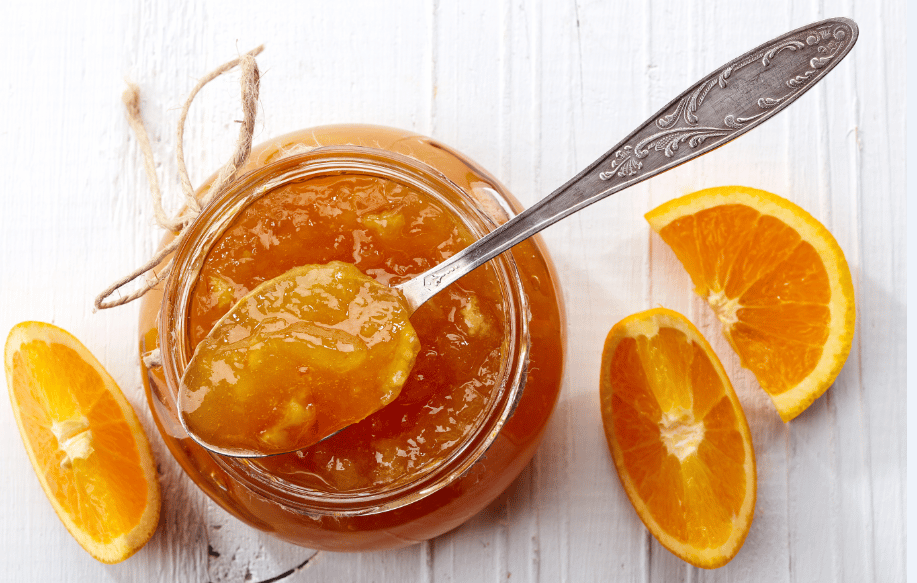It may be cold outside, but inside you can create a sunnier disposition courtesy of making
some marmalade with Seville Spanish oranges – which are now in season. Times food writer Bruce McMichael shows you how…
FOR many people, buying Seville oranges – marmalade’s main ingredient – is a ritual closely associated with New Year. The Spanish fruit have a short growing season and are usually found in British shops in January and February, and while they may be too sharp to eat raw, by simply adding sugar (and for some lemon) and some heat, they are cleverly transformed into a timeless British breakfast table classic.
Making your own marmalade is as much a science as an art because using the same
ingredients and methods year after year does not guarantee you’ll get the same flavour or taste again and again. And remember that keeping a close eye on the time and temperature of the boiling, bubbling pot is absolutely key to making the best marmalade you can.
Mike Goode a locally-based designer, became a keen marmalade maker after finding shop-bought products too sugary.
“Most commercial brands are too sweet for my palate so I prefer to make my own. It’s an annual ritual in our house and something we really look forward to,” he says.
Jane Hasell-McCosh, owner of Dalemain Mansion in Cumbria, where she founded the
annual World’s Original Marmalade Awards & Festival, says: “Marmalade is part of our culture, and is something that has always been popular to make at home. It is a very sophisticated food with a fascinating range of ways of using it – marmalade is not just for toast!”
Artisan marmalades and preserves are often found at farmers’ markets across West Kent, including those at Penshurst, Tunbridge Wells and Tonbridge. Local producers include Potash Farm, who add Kentish Cobnuts to their products, Tonbridge-based Great Preservations and mother and daughter team Edna and Anna Redman of Sugar and spice. The latter are regulars at Penshurst where their use of seasonal produce is popular with customers who yearn for that homemade taste and flavour but just don’t have the time to make their own.
As a result of such a buoyant local offering, Tonbridge farmers’ market is hosting Marmalade Month in March.
Manager Steve Wood says: “We have some great marmalades on offer at the market, and there’s always lots of interest from our shoppers at this time of year in the new batch of Seville orange marmalade. We’ll have lots of sales and cooking demos showing how versatile a product it is.”
If you’re thinking of making your own you’re bound to get plenty of advice. Matthew Kearsey-Lawson is an award-winning chef at Kent Fine Foods. His top tips are to freeze
the oranges first, to cut the peel thickly, and to watch the heat and time very closely. Matthew says: “Everyone has their own rules about making marmalade. But in truth there are no rules… except these three!”
Enthusiastic marmalade maker and local food writer and author Mary Gywnn, who wrote the bestselling Back In Time For Dinner and The WI Cookbook – The First 100 Years, prefers to boil the whole fruit before squeezing her Sevilles and then shredding the peel by hand.
Championship organiser Jane advises the
following: “Make sure that you get fresh fruit,
ensure that your peel is well cooked before you
add your sugar, and fill your jar right to the top
to avoid mould!”
But whatever marmalade method you decide to adopt, now is the time to stock up on Seville oranges, settle into your kitchen, switch the radio on and get stuck into making your very own creation.
And who knows, you may well end up entering it into the World Championships!
This recipe is how Pam ‘The Jam’ Corbin, Head Judge at the World’s Original Marmalade Championships, makes hers…
INGREDIENTS
n 1kg Seville oranges
n Juice of 2 lemons (100mls)
n 2kg golden granulated sugar
METHOD
1. Scrub the oranges, remove the buttons at
the top of the fruit, then cut in half around
their circumference. Squeeze out the juice and
keep to one side.
2. Slice the fruits into the size pieces you
prefer, removing any marked skin and any
thick pieces of the white inner pith. Save these
– the pith is where the most pectin is. Tie
these off-cuts in a square of muslin.
3. Place the sliced peel, orange juice and pith
bag in a large bowl and cover with 2 litres of
water. Cover and leave to soak overnight or for
up to 24 hours – this helps to soften the peel
and release the pectin.
4. Transfer the whole mixture to a large heavy
based pan or preserving pan. Cover and bring
to the boil, then simmer for about 2 hours
(Seville’s have tough old skins) or until the
peel is tender and breaks when gently pulled
– the contents of the pan will have reduced by
approximately one- third. Remove the pith
bag, first squeezing it firmly against the side
of the pan to remove all its gummy goodness.
5. Add the lemon juice and the sugar. Bring
the mixture to the boil, stirring until the sugar
has dissolved. Boil rapidly until setting point
is reached -this should take approximately 15
minutes at a full rolling boil but will depend
on the size of pan you use and how hard the
boil is. The marmalade is done when the mass
of foamy bubbles on the surface has
disappeared and the mixture appears to be
thick and glossy.
6. Test for setting point by dropping the
mixture on to a very cold plate or a large
stainless steel spoon – after a minute or so it
should form a slight skin on the surface. Avoid
overcooking, which results in a stiff, overlysweet
marmalade.
7. Remove from the heat and leave to cool for
several minutes to allow the peel to evenly
distribute – if you pour when the marmalade
is too hot the peel will float to the top of the
jar.
8. Pour (to within 3 mm of the top) into
sterilised jars and seal immediately.








